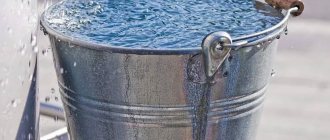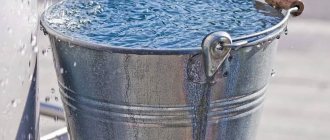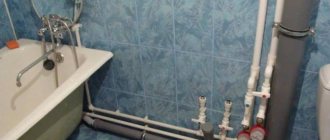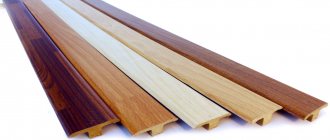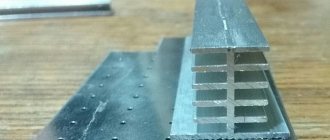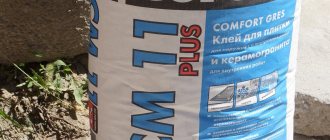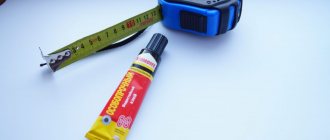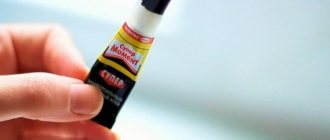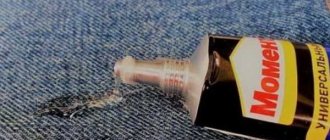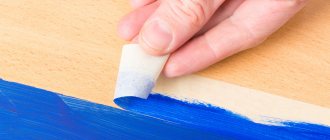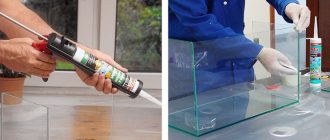Every person throughout his life has a need to glue paper and cardboard products. At home or in the office we have to deal with paper glue.
Especially often children and creative individuals who do crafts, modeling, quilling and other similar things work with adhesives. Often during such events a dilemma arises: how to glue cardboard to cardboard, or how to glue cardboard to other materials - wood, various fabrics, metal, plastics.
It’s worth mentioning right away that cardboard has properties that are distinctive from paper. It is denser and harder, so working with it using silicate glue and especially a glue stick is irrational. While small pieces of cardboard can still be glued with silicate glue, heavier pieces will simply fall off.
So what should creative people do? They need to choose the right glue for their activity. Below we will look at the most popular types of adhesives, but first let’s define the criteria from which we will build.
General rules that will help distinguish good glue from bad
To ensure that the creative process brings joy, and its result does not fall apart at the first opportunity, you need to choose an adhesive that is suitable for solving your problem.
Agree, in children's creativity you need glue that is at least safe, and in the office it definitely should not have a pungent odor.
But no matter what your goals are, you are unlikely to be interested in buying bad glue. Let's take a look at the general rules that will protect you from such a mistake.
A quality product must have:
The right consistency. It is inconvenient to work with thick ones, because it is difficult to apply and the consumption will be large. If the consistency is liquid, then we can end up with paper soaked through with adhesive and deformed when drying.
Shelf life sufficient for repeated use. Expired glue is unpredictable in operation.
It may not have the properties we need, it may form lumps, or separate. Adhesion sufficient to firmly bond the materials you intend to work with.
No pungent odor. It is better to glue using safe means. Especially if the process is carried out indoors. Use toxic substances only as a last resort when other options fail.
Think about the comfort of your future work. Need to glue large surfaces? It is more convenient to apply glue with a brush. For joints, products with a spout are certainly better suited.
Undoubtedly, work looks neater when there are no visible glue smudges or stains in the places where it was applied.
That is why, with the same adhesive properties, it is better to choose a colorless analogue.
Well, if the glue does not turn yellow over time and does not spoil the result, it will be an ideal solution for products that require a lot of time and effort to create.
Popular types of glue suitable for working with cardboard and paper
First, let's look at three hits that are most often chosen by both amateurs and professionals. At the same time, we’ll figure out how they differ.
Glue stick
A popular classic, adored by both office workers and kindergarten teachers. Easy to use for adults, suitable for children too. Lightweight, economical in use, and when used correctly, does not leave marks on fingers or paper.
Apply evenly and in a thin layer. Compact, easy to store, takes up little space, and is inexpensive.
It would seem beautiful. However, it is still better to use such glue for working with small parts, applications, and simple manipulations with paper.
With its denser types, for example, when modeling complex structures made of cardboard, a glue stick will not cope.
A bit weak. The joints may come unglued at the wrong time, and all the work will go down the drain.
For more substantial and durable paper products, it is better to look for something with more serious characteristics.
PVA can do anything
For example, polyvinyl acetate (PVA)-based glue works great on thick paper and even cardboard. Very good when used in papier-mâché technique.
It has excellent properties that allow you to create crafts from a variety of materials. Fabric, feathers, wood, leather.
No problem! The main thing is to take into account that PVA has varieties. So PVA-K refers to office adhesives. It makes it easy to glue any type of paper, including photo paper. PVA-MB has advanced characteristics and richer capabilities.
In fact, this is already a universal glue. In addition to paper and cardboard, it allows you to work even with glass and metal surfaces.
Despite the fact that outwardly PVA is a yellowish or white liquid, it leaves no traces when dried.
The smell is weak, non-toxic, explosion- and fireproof. When storing, be sure to close it tightly, otherwise a “plug” will form, which makes further use difficult.
That is why PVA is available in small packages with a brush or nozzle with a spout.
It is recommended to shake thoroughly before use. It takes 3-5 minutes for the materials to be glued to set, but complete drying occurs within a day.
Super glue
Something that can almost always be bought not only in specialized stores offering repair products, but also in hardware stores and even grocery stores.
“Moment”, “Second” are perhaps the most famous representatives of this segment. The name speaks for itself. This glue can handle almost anything. It sticks everything together and you have to work with it very carefully.
Such an assistant should be kept as far away from children as possible. The cyanoacrylate base is the key to almost instant high-quality adhesion.
Firmly grips porous materials, rubber, wood, plastic, metal, fabric and more. And fingers, if you don’t take into account the safety rules (hands cannot be washed with water, you need at least acetone).
Bonding provides the most reliable, but is toxic, as evidenced by the sharp, chemical smell. The room must be ventilated.
Not recommended for working with materials containing cellulose. Enters into a chemical reaction with a large release of heat. This also applies to the clothes you are going to wear to work.
The paper sticks and does not deform. It takes skill to get a quality result.
Adhesive suitable for photographs
First of all, pay attention to the glue sticks sold in stores that say “for photos.”
Their adhesive strength is higher than that of classic ones in the same packaging. At the same time, they have the same application advantages. Apply in a thin layer, economical, easy to use. Use this pencil to walk around the perimeter of the photo and straight into the album. Nothing complicated. Erich Krause, Ranger, Aleene's - any of these brands will not disappoint the consumer.
There is glue similar to PVA. It's called Acid-free Tacky Glue. After working with it there are no stains, it does not turn yellow, and it is optimal in consumption, despite its liquid consistency. It’s convenient to use – it comes with a nozzle spout.
UHU Creativ, another high-quality glue for photographs, is very similar in structure to Moment, but unlike it, it is non-toxic and does not have a strong chemical odor.
UHU Creativ allows you to attach photos not only to paper, but also to skin. You don't have to worry about deformation of even thin paper.
Also check out UHU Twist & Glue. Although its texture is runny and it takes longer to dry, it is guaranteed not to spoil either paper or photographs. If you are not allergic, you can use Moment Crystal glue.
It can be called harmless only after drying, but during operation this product is quite toxic.
Contains acetone, so the room must be ventilated. Suitable for gluing rubber, plastic, leather, paper. It's also easy to handle photographs.
CORRUPTED CARDBOARD CATALOG
Filter
Corrugated cardboard, two-layer brown. Roll width 1050 mm. Roll winding 150 m.
| Width | 1050mm |
4 R
4308 R
Corrugated cardboard, two-layer brown. Roll width 1260 mm. Roll winding 150 m.
| Width | 1260mm |
5 R
5170 R
Corrugated cardboard, two-layer brown. Roll width 1400 mm. Roll winding 150 m.
| Width | 1400mm |
5 R
5732 R
Corrugated cardboard, two-layer brown. Roll width 1400 mm. Roll winding 50 m.
| Width | 1400mm |
1 R
1915 R
Corrugated cardboard sheet T-22 brown. Size 2000x1020 mm.
| Length | 2000mm |
| Width | 1020mm |
62 R
62 R
Corrugated cardboard P-32 drill. Size: 1350x2500 mm.
| Length | 2500mm |
| Width | 1350mm |
274 R
274 R
Corrugated cardboard P-32 drill. Size: 2000x1020 mm.
| Length | 2000mm |
| Width | 1020mm |
148 R
148 R
Corrugated cardboard P-32 drill. Size: 2300x1200 mm.
| Length | 2300mm |
| Width | 1200mm |
198 R
198 R
Corrugated cardboard P-32 drill. Size: 2400x1200 mm.
| Length | 2400mm |
| Width | 1200mm |
234 R
234 R
Corrugated cardboard P-32 drill. Size: 2500x1500 mm.
| Length | 2500mm |
| Width | 1500mm |
319 R
319 R
Corrugated cardboard P-33 drill. Size: 2000x1020 mm.
| Length | 2000mm |
| Width | 1020mm |
180 R
180 R
Corrugated cardboard P-33 drill. Size: 2400x1200 mm.
| Length | 2400mm |
| Width | 1200mm |
247 R
247 R
Corrugated cardboard T-21 drill. Size: 1200x1000 mm.
| Length | 1200mm |
| Width | 1000mm |
43 R
43 R
Corrugated cardboard T-21 drill. Size: 1200x800 mm.
| Length | 1200mm |
| Width | 800mm |
34 R
34 R
Corrugated cardboard T-21 drill. Size: 2000x1050 mm.
| Length | 2000mm |
| Width | 1050mm |
75 R
75 R
Corrugated cardboard T-21 drill. Size: 2000x1260 mm.
| Length | 2000mm |
| Width | 1260mm |
91 R
91 R
Corrugated cardboard T-22 drill. Size: 2000x1020 mm.
| Length | 2000mm |
| Width | 1020mm |
73 R
73 R
Corrugated cardboard T-22 drill. Size: 2000x1220 mm.
87 R
87 R
- >
We produce any type of rolled and sheet corrugated cardboard.
If you don't find one that suits you in the catalog, place an individual order.
Other products
Archival boxes
Waterproof cardboard
White corrugated cardboard
Protective corners
Cardboard spacer
Boxes for small items
Sheet corrugated cardboard
Food grade cardboard
Popular corrugated packaging
Archival box From 212 rub.
Moving box From RUR 87
Gift box From 1023 rub.
Cake box From 432 rub.
What other options are there for gluing cardboard and paper?
If you need to glue durable paper, you can use glue containing acrylic.
It comes in the form of a spray, so it is practical, easy to apply, and does not get your hands dirty. It must be taken into account that a surface that is too thin will not work, as there is a risk of deformation of the material.
It turns yellow over time, so it should not be used on the front side of a future structure.
Stationery silicate glue with increased adhesion (“liquid glass”) is also suitable for such purposes. When hardened, it becomes a transparent mass. It is widely used to create three-dimensional products using the papier-mâché technique.
You can glue not only paper, but also cardboard. However, the seams become brittle over time and may come apart. Should not be used for working with photographs. Over time, the image at the gluing site will fade and blur.
Another little-known way to work with paper is gum arabic glue. Contains water and gum arabic. Reliably glues, is safe for humans, and has a high degree of adhesion. It is rarely found in finished form.
But it’s quite easy to make at home by mixing 10 g of gum in 20 ml of water. This is what some craftsmen who are familiar with this technology do.
You can use wood glue - reinforced PVA or based on casein, flesh, fish or bone meal.
Although this composition may have an unpleasant odor and resemble jelly, the product does not turn yellow and does not crumble over time. It grips paper and cardboard well, you can make crafts, glue fabric.
DIY frame made of cardboard covered with fabric
Covering a finished frame with fabric is very easy; a DIY frame made from cardboard is quite suitable. For this design, a passe-partout in which the cardboard parts are already cut is best suited. You won't have to sew anything. The synthetic padding of the front part is glued to the frame. Then the other part of the frame and the stand are carefully covered with smooth or patterned fabric, which is also glued. You can buy fabric specifically for the frame or use scraps.
How to make a frame
Take a piece of fabric about 4 times larger than the frame and add 2 cm on all sides for the lapels. Choose a dense, not very heavy fabric. Bulky fabrics are not suitable as they bend poorly and slippery fabric is difficult to work with.
For the back of the frame and stand, use thick cardboard. To make the edges smoother, cut with a special knife along a metal ruler. In addition, you also need a clean acrylic sheet.
You will need:
- Prefabricated passe-partout
- Knife-cutter
- Metal ruler
- Cardboard
- Textile
- Synthetic winterizer of medium thickness
- Spray glue or glue stick
- PVA glue
- Blank Acrylic Sheet
The back of the frame. Measure the length and width of the mat, cut out a cardboard piece using a ruler, 3 mm smaller on all sides.
Cut out the fabrics. Cut out 2 rectangles the size of a mat, adding 2 cm on each side for the lapels. Check the position of the fabric pattern.
Open the padding polyester. Apply glue to one side of the mat and place it on the padding polyester. Using scissors, cut the synthetic padding along the contour and in the middle.
Covering with padding polyester. Apply glue to the padding polyester glued to the frame and carefully place it on a rectangle of fabric. Cut off the corners of the fabric flaps at a distance of no more than 3 mm from the corners of the cardboard.
Gluing the lapels. Apply PVA glue to the long edge and turn the allowance onto the back of the frame. Without moving the frame and padding, stretch the fabric and press tightly. Glue the other long edge in the same way. Apply glue to the short edge, slightly turn the diagonal cut of the corner, turn it over and glue the fabric to the frame from the back. Glue the second short edge in the same way.
Pasting the frame cutout. Cut the fabric in the frame opening, leaving a 2 cm allowance. Make diagonal cuts in the corners, 2 mm short of the edge of the cardboard. Lubricate all the flaps one by one with PVA glue and screw them onto the frame. Stretch the fabric and press it against the frame.
Covering the outside of the frame at the back. Apply spray adhesive to the back of the frame and carefully place it with the adhesive side on the back of the remaining fabric. Glue the flaps as indicated in step 5.
Sealing the inside of the back of the frame. Measure the length and width of the back of the frame, cut out the same rectangle from the fabric with an allowance of 2 cm on one short side, reducing the remaining three by 3 mm. Fold and glue the hem. Apply PVA glue to the back of the fabric and glue the fabric to the back of the frame.
Frame assembly. Apply PVA glue to the unfolded short and long cuts of the inside of the back of the frame. Aligning the hem of the back piece with the short side of the front piece, glue the frame together. The unglued edge is the top one. Cut a photo-sized rectangle from an acrylic sheet and insert it into the frame through the slot at the top.
Advice. Gluing under pressure. To ensure that the fabric lies flat and does not bulge at the corners, after gluing each part, place the frame under the press: carefully place it between two layers of padding polyester and press it on top with something heavy. The frame is ready.
How to make a stand
Open the stands. Cut out part of the cardboard stand according to the diagram so that axis A is 1 cm shorter than the frame. Mark the fold with a dotted line. Cut out the second part according to the pattern of the shaded area.
Cut out the fabric for the stand. Using the cardboard pieces, cut out two pieces of fabric with 2 cm allowances on all sides.
Covering the stand. Apply spray adhesive to the cardboard parts and glue them to the underside of the fabric parts. Cut out the corners at the seam allowances. Glue all the allowances one by one with PVA glue to the wrong side of the cardboard.
Securing the stand. Apply PVA glue to the underside of the smaller part. Matching the edges, glue the parts of the stand together with the wrong sides. Apply PVA glue to the exposed part of the stand. Align the bottom left corner of the frame with the bottom corner of the stand and glue the stand to the back of the frame.
Another master class on making a frame with your own hands from cardboard
Source
SHARE! "Cross" will not give bad advice!
